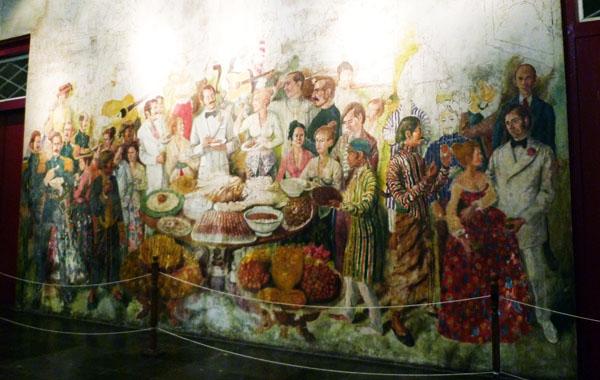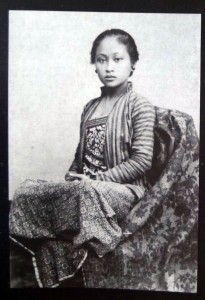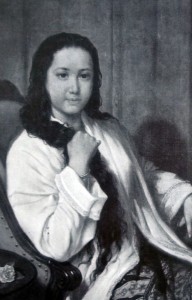
accessories
23 Mar 2011
Women's Fashion Tempo Doeloe
When I was invited to see Animated Interactive Performance last Saturday that was held by British Council in their old town revitalization program called Mystery of Batavia, I just knew that Fatahillah Museum has a secret chamber painted with unfinished mural by Harijadi Sumodidjojo. The mural was accidentally found by a group of British and Indonesian artist around 0n 2010. The mural painting (as captured on the photo above) depicts multi-ethnic society in Batavia during Dutch governance. Indonesian native, Dutch, even Arabian and Chinese people with various attires are found in the painting. That makes me wonder about the fashion at the era.
But thanks to British Council who lent us a book titled Tropenecht: Indische en Europese kleding in Nederlands-Indie by Dorine Bronkhorst. D and Esther Wils. The book, roughly translated as Tropical Sea: Indian and European clothing in the Dutch East Indies, gave much idea and images about the style in Indonesia during Dutch colonialism, or we can call it “fashion tempo doeloe“. Flipping through its pages gives me the experience as if I was at the era, observing people’s attire. Although I can’t read Dutch, the photos and the help of Google Translate are enough for me to understand and share to you about “fashion tempo doeloe”.
What interesting is, each ethnic gives influence to other ethnics in the way of dressing. For example, it’s common to see European women wearing Indonesian traditional attire, and vise versa. Here are some trend that I find:
1. Kebaya & Sarung
(From left to right photos) Chinese descendant or peranakan, Javanese and European ladies clad in kebaya and sarung.
According to this book, white kebaya and sarung are inextricably linked with the old Indonesia, or tempo doeloe during the early 19th century. The book provides many photos of women in kebaya and sarung By 1920, kebaya and sarong became the outfit worn at home by European women and Indonesian women that married to European. The book stated that the color is white maybe because on almost all of the photos that feature kebaya, the color is white.
 Kebaya, mostly made of cotton, is suitable for tropical climate like Indonesia has. Even many European women chose kebaya as their everyday attire while they were in Indonesia. Kebaya as seen on the above and below photos are commonly found and worn by European women in Indonesia. The kebaya is detailed with lace, white, and made of cotton.
Kebaya, mostly made of cotton, is suitable for tropical climate like Indonesia has. Even many European women chose kebaya as their everyday attire while they were in Indonesia. Kebaya as seen on the above and below photos are commonly found and worn by European women in Indonesia. The kebaya is detailed with lace, white, and made of cotton.
While sarung, as the companion for kebaya, also came in various style and motifs. Batik sarung also became the medium to tell tales. As on the photo below, batik uniquely records the figure of Red Riding Hood with bilik (traditional Javanese motif) as the background.
2. Corset and Long Dress
As I stated before, the way Indonesian and European women dressing at that era influenced each other. While kebaya and sarung as Indonesian traditional attires were also worn by European women, structured long gown that was brought by European women was worn by Indonesians too. From the photo above, it seems that corsets was worn by some women to result in more defined waist, padded at the shoulders, and the skirt was filled with crinoline to make it more voluminous.This trend started from about 1870 until 1910’s. The book mentioned that “Empress Eugine, the most beautiful woman of the Old Continent, set the tone in the field of women’s clothing. The crinoline, with or without silk slips, lace and pleated skirts or flower garlands made, was rampant.”
Again, white was the most favorite color for the long dress. To complete the look, the hair was kept in chignon and sometimes accessorize with hat. Photo below captures both Indonesian and European women dresses together in white.
3. Kimono
Kimono added the variety of clothing for both Indonesian and European women. Actually, kimono was widely considered the new cool thing compared to the former trend of kebaya and sarung. According to the date listed on the photos, kimono was popular during 1910’s – 1930’s. With its ankle-length bottom and wide sleeves, the kimono was made of silk or crepe. It attire was often worn for afternoon tea. This book stated that many kimono was imported from Shanghai and could be bought at Chinese’s kelontong store. Some European stores at Batavia sold kimono too.
By the way, you really should check out the Mystery of Batavia Animated interactive performance I mentioned above. It’s a great way of appreciating the history of this city we love (or sometimes hate :D) and it is presented using a combination of art and technology and really captures the mystery of the old town. Check out the performance schedule here.
And also stay tuned to our Twitter account because we will be giving away tickets for you!
Special thanks to British Council Indonesia for providing us the material













